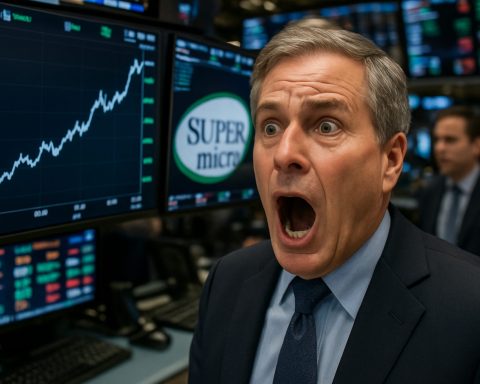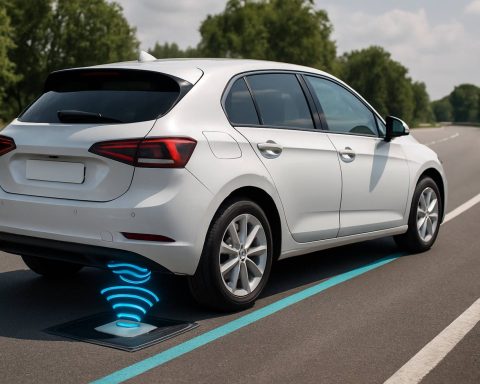- Tariffs of 64.9% on Chinese EV battery imports could significantly increase EV production costs in the U.S.
- China, a major supplier, might lose market share, while Japan and South Korea could benefit due to lower tariffs.
- EV adoption may slow as rising costs make these vehicles less affordable for the average consumer.
- Former President Trump’s policy changes include retracting EV tax credits and favoring fossil fuels.
- Opportunities exist for domestic battery production, but challenges involve raw material imports and international trade relations.
- Tesla and the broader EV market face uncertainty, with Tesla missing Q1 2022 delivery targets amid policy shifts.
- The U.S. faces a critical moment in its journey toward sustainable innovation as it navigates these challenges.
A new storm is brewing on the horizon of the electric vehicle (EV) market. With the swipe of a pen, former President Trump has initiated a seismic shift in the landscape of American innovation and trade. Heavy tariffs targeting imported EV battery cells have been set in motion, with a staggering 64.9% rate now levied on Chinese imports. China, the leading supplier, accounted for a hefty 70% of the U.S. battery cell market, but this relationship teeters on the brink as costs skyrocket.
As the clouds of these tariffs gather, they threaten to overshadow the nascent rise of electric vehicles, whose adoption was gaining momentum across the United States. For the average consumer, already cautious about embracing this shift in technology, the looming rise in EV production costs feels like a palpable jolt. Hindered by the dramatic increase in tariffs, the cost of EV batteries—which already represent a third of the total cost of vehicles like Tesla’s Model 3—could soar, rendering these cars less attainable to the mainstream buyer.
The numbers paint a stark picture: an additional $8 billion in costs is set to weigh down on manufacturers and consumers alike. The global trade landscape is adjusting in real-time as Japan and South Korea, facing comparatively lower tariffs, stand ready to expand their market share at China’s expense. Yet, this fragile balance brings no immediate relief to the American market.
Against this backdrop, former President Trump’s bold policy reversal further chills the EV sphere. By retracting EV tax credits and loosening mandates, there’s a distinct shift back to fossil fuel preferences, encapsulated by the “Unleashing American Energy” directive. Reassurances of consumer freedom conceal an underlying message: a return to gasoline-powered roots. The dismantling of these tax incentives could quiet the buzz that once surrounded the promise of a cleaner, electrified future.
The U.S. EV industry now faces a pivotal moment; the increase in tariffs may slow the rush towards electric mobility. Amid the economic thorns sits a solitary rose—an opportunity for American battery production to grow domestically. Yet, the path is fraught with challenges: restrictive raw material imports and potential retaliatory moves by trading partners paint a complex web for policymakers to untangle.
For Tesla, the EV heavyweight, the narrative becomes jarring. A decline to just 336,681 deliveries in Q1 2022 missed Wall Street’s mark decisively, hinting at the broader unease shaking EV giants. Consumer hesitation could stem from cost concerns and a retreat from EV exploration, amplified by the cessation of financial incentives.
Ultimately, the confluence of these policies may redefine America’s role in the electric vehicle saga. The triumph of innovation hangs in the balance, waiting for decisive, visionary leadership to steer through this tempest. As the industry recalibrates, the larger question looms: how will America chart its course in a world racing toward sustainability and innovation? The coming years will be telling.
Electric Vehicle Storm: Navigating Tariff Impacts and Future Prospects
Unpacking the Impact of U.S. Tariffs on the EV Market
The electric vehicle (EV) industry finds itself at a crossroads following significant policy changes initiated by former President Trump. By imposing a staggering 64.9% tariff on imported Chinese EV battery cells, the U.S. aims to reshape its trade dynamics—a move with profound implications for the global EV market. As China supplied approximately 70% of the U.S. battery cell market, this tariff could dramatically alter the landscape, potentially increasing costs by $8 billion for manufacturers and consumers.
How the Tariffs Could Affect Consumers
1. Rising Vehicle Costs: EV batteries contribute significantly to the total cost of vehicles such as Tesla’s Model 3. With the increased tariffs, these costs are likely to rise, making EVs less accessible to average consumers.
2. Shift to Alternative Suppliers: As China faces the brunt of these tariffs, countries like Japan and South Korea, with lower tariff rates, could increase their market share. However, the American market might not see immediate relief from this shift due to existing supply chain complexities.
3. Diminished Incentives: The retraction of EV tax credits could further discourage potential buyers by increasing the overall cost of adopting EV technology, leaning consumer preference back towards traditional gasoline vehicles.
Opportunities and Challenges for Domestic Production
While tariffs pose significant challenges, they also present an opportunity to boost domestic battery production. However, realizing this potential requires overcoming numerous hurdles, such as securing raw materials and dealing with potential retaliatory measures from trading partners.
Real-World Use Cases: Responding to Global Shifts
– Domestic Manufacturing Boost: Companies may invest in domestic battery cell production facilities to mitigate the impact of import tariffs. This could lead to job creation and reduced dependency on foreign suppliers.
– Strategic Partnerships: U.S. manufacturers might seek alliances with Japanese and South Korean firms to leverage their comparatively lower tariff burdens.
Market Forecast and Industry Trends
1. Increased Focus on Innovation: To counter rising costs, manufacturers may accelerate innovation to produce more cost-effective and sustainable battery solutions.
2. Legislative Adjustments: Future administrations may need to reconsider current tariff policies and tax credits to better align with global sustainability goals.
Pros & Cons Overview
Pros
– Encourages domestic production and job creation.
– Potential to boost technological innovation in battery manufacturing.
Cons
– Increased EV costs for consumers.
– Potential slowdown in EV adoption.
– Retaliatory trade measures from impacted countries.
Quick Tips for Navigating the Changing EV Landscape
– Consider Alternative Models: Consumers should explore models from countries less affected by tariffs, which may offer competitive pricing.
– Stay Informed on Tax Credits: Monitor potential changes in tax policies, as future legislation could reinstate incentives.
– Explore Financing Options: As prices rise, look into various financing options to offset the immediate impact on your budget.
Conclusion: Charting a New Course
The U.S. EV industry stands at a pivotal juncture, requiring strategic leadership and innovation to navigate the challenges posed by new tariffs. With a focus on domestic growth and global collaboration, the industry can maintain its trajectory towards a sustainable future. For further insights into the evolving world of electric vehicles, explore resources from Tesla and U.S. Department of Energy.












